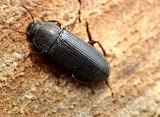
Mealworm
Overview
Mealworms are the larval form of the mealworm beetle, Tenebrio molitor, a species of darkling beetle
. Like all holometabolic
insect
s, they go through four life stages: egg
, larva
, pupa
, and adult
. Larvae typically measure about 2.5 cm or more, whereas adults are generally between 1.25 and 1.8 cm in length.
Mealworms are typically used as a food source
for reptile
, fish
, and avian
pet
s. They are also provided to wild birds in bird feeder
s, particularly during the nesting season, when birds are raising their young and appreciate a ready food supply.
Darkling beetle
Darkling beetles are a family of beetles found worldwide, estimated at more than 20,000 species. Many of the beetles have black elytra, leading to their common name...
. Like all holometabolic
Holometabolism
Holometabolism, also called complete metamorphism, is a term applied to insect groups to describe the specific kind of insect development which includes four life stages - as an embryo or egg, a larva, a pupa and an imago or adult. Holometabolism is a monophyletic trait that all insects in the...
insect
Insect
Insects are a class of living creatures within the arthropods that have a chitinous exoskeleton, a three-part body , three pairs of jointed legs, compound eyes, and two antennae...
s, they go through four life stages: egg
Egg (biology)
An egg is an organic vessel in which an embryo first begins to develop. In most birds, reptiles, insects, molluscs, fish, and monotremes, an egg is the zygote, resulting from fertilization of the ovum, which is expelled from the body and permitted to develop outside the body until the developing...
, larva
Larva
A larva is a distinct juvenile form many animals undergo before metamorphosis into adults. Animals with indirect development such as insects, amphibians, or cnidarians typically have a larval phase of their life cycle...
, pupa
Pupa
A pupa is the life stage of some insects undergoing transformation. The pupal stage is found only in holometabolous insects, those that undergo a complete metamorphosis, going through four life stages; embryo, larva, pupa and imago...
, and adult
Imago
In biology, the imago is the last stage of development of an insect, after the last ecdysis of an incomplete metamorphosis, or after emergence from the pupa where the metamorphosis is complete...
. Larvae typically measure about 2.5 cm or more, whereas adults are generally between 1.25 and 1.8 cm in length.
Mealworms are typically used as a food source
Food
Food is any substance consumed to provide nutritional support for the body. It is usually of plant or animal origin, and contains essential nutrients, such as carbohydrates, fats, proteins, vitamins, or minerals...
for reptile
Reptile
Reptiles are members of a class of air-breathing, ectothermic vertebrates which are characterized by laying shelled eggs , and having skin covered in scales and/or scutes. They are tetrapods, either having four limbs or being descended from four-limbed ancestors...
, fish
Fish
Fish are a paraphyletic group of organisms that consist of all gill-bearing aquatic vertebrate animals that lack limbs with digits. Included in this definition are the living hagfish, lampreys, and cartilaginous and bony fish, as well as various extinct related groups...
, and avian
Bird
Birds are feathered, winged, bipedal, endothermic , egg-laying, vertebrate animals. Around 10,000 living species and 188 families makes them the most speciose class of tetrapod vertebrates. They inhabit ecosystems across the globe, from the Arctic to the Antarctic. Extant birds range in size from...
pet
Pet
A pet is a household animal kept for companionship and a person's enjoyment, as opposed to wild animals or to livestock, laboratory animals, working animals or sport animals, which are kept for economic or productive reasons. The most popular pets are noted for their loyal or playful...
s. They are also provided to wild birds in bird feeder
Bird feeder
A birdfeeder, bird feeder, bird table, or tray feeder are devices placed outdoors to supply bird food to birds...
s, particularly during the nesting season, when birds are raising their young and appreciate a ready food supply.
Unanswered Questions
Discussions

